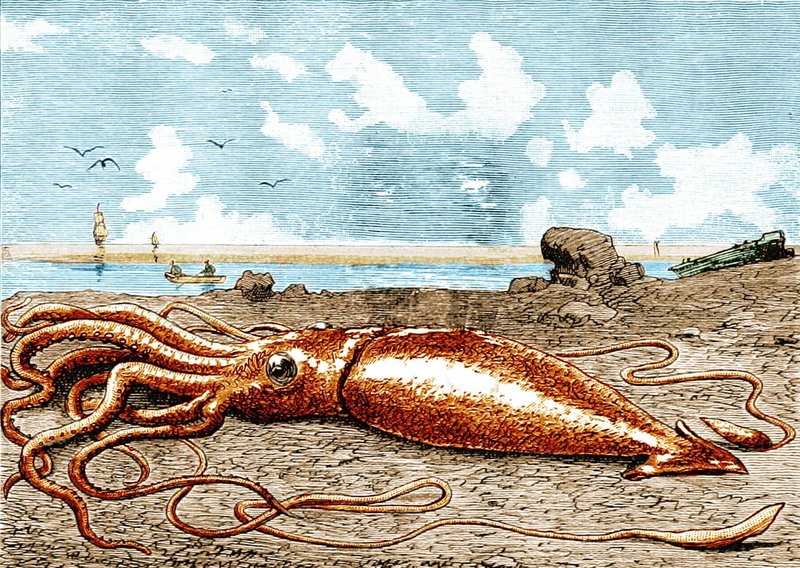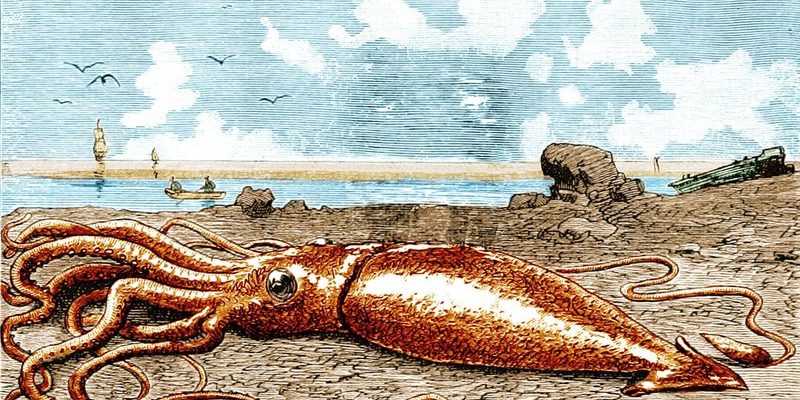
Interestingly, these massive cephalopods have thrived for millions of years, evolving in ways that continue to fascinate scientists today. Their journey isn’t just about survival but about adapting to the ever-changing environment of our oceans. Let’s dive into the incredible evolutionary tale of the giant squid, exploring its origins, adaptations, and the challenges it faces in our modern seas.
Origins of the Giant Squid
The story of the giant squid begins with its ancestors, who swam the ancient oceans over 500 million years ago. These early cephalopods were quite different from the giant squid we know today. They evolved from creatures called mollusks, which are similar to snails and clams. What’s really interesting is that while many species have come and gone, squids have managed to persist and adapt through various mass extinction events.
The giant squid belongs to the family Architeuthidae, which includes some of the largest invertebrates on the planet. Scientists believe that these squids evolved to grow larger over time as a means of avoiding predators, and their size gave them advantages in hunting for prey, too. Just picture it: being able to swim swiftly and powerfully through the water, all while keeping a watchful eye out for anything that might want to take a bite out of you!
You might be wondering how they managed to stay hidden in the depths of the ocean. Their camouflage abilities are a big part of the equation. With special skin cells called chromatophores, giant squids can change their color and blend into their surroundings, making them less visible to both predators and prey. This skill might be one of the key reasons we still know so little about their behavior and habitat.
Physical Characteristics
What sets the giant squid apart from other squids? For starters, their sheer size. These creatures can reach lengths of up to 43 feet! To put that in perspective, that’s longer than a minivan. Their bodies are streamlined, which helps them move quickly through water, while their long tentacles are equipped with suckers that allow them to grip and capture prey effectively.
The anatomy of a giant squid is designed for life in the deep sea. They have large, advanced eyes—some of the biggest in the animal kingdom—allowing them to see in low-light conditions. This becomes crucial when you’re hunting in the dark depths of the ocean. These giant eyes are essentially a tool for survival, giving squids the ability to detect movement and navigate their habitat.
However, let’s not forget their beaks, similar to those of birds, which help them eat their main diet of fish and crustaceans. You might think of them as the ultimate underwater predators, capable of swiftly ambushing their lunch from the deep.
Adaptations for Survival
Over millions of years, giant squids honed a variety of adaptations that have allowed them to thrive in the ocean’s depths. As predators, they are constantly evolving to increase their efficiency in hunting. For example, they can move rapidly by expelling water from their bodies, a method called jet propulsion. This gives them a quick escape from predators like sperm whales, which are among their few natural enemies.
Their ability to change colors is also an adaptation that serves multiple functions. Not only does it help them evade predators, but it can also be used for communication with other squids. Imagine having a conversation by changing your outfit in a split second—an incredibly useful social tool in the vast underwater world!
Giant squids also possess a remarkable ability to regenerate lost limbs. If a predator manages to snatch one of their tentacles, they can grow it back over time. This capacity for regeneration means they can maintain their hunting prowess and defend themselves even after an encounter with danger.
The Role of Giant Squids in the Ecosystem
In the grand scheme of the ocean’s ecosystem, giant squids play an essential role. They act as both predators and prey, helping maintain balance in marine food webs. As they hunt smaller fish and crustaceans, they help control those populations. At the same time, their size makes them an important food source for larger predators, such as sperm whales and even some shark species.
You might not realize it, but the presence of giant squids can indicate the health of marine ecosystems. If their populations decline, it can signal problems within their environment, such as overfishing or pollution. Thus, studying these remarkable animals can provide valuable insights into the condition of our oceans.
Moreover, their unique hunting strategies contribute to the transfer of energy within the ocean. When they eat smaller creatures and are, in turn, eaten by larger ones, they help move energy up the food chain. Their existence is a reminder of how every species, no matter how seemingly obscure, plays a role in the balance of nature.
Challenges Faced by Giant Squids
While giant squids have adapted beautifully over time, they still face significant challenges today. Climate change is one of the biggest threats, affecting ocean temperatures and currents. As habitats change, their food sources may also be impacted, leading to potential declines in their populations.
Pollution, particularly plastic waste, can pose dangers as well. Ingesting plastic debris can lead to health issues for giant squids, just like it does for many marine creatures. This pollution disrupts the delicate balance of marine ecosystems and calls for urgent action to protect these enigmatic animals.
Fishing practices can also be a threat. Though they’re not heavily targeted, bycatch in fishing nets can unintentionally trap giant squids. This not only takes individual squids out of the population but disrupts their survival strategies in their natural habitat.
The Fascination with Giant Squids in Culture and Science
The giant squid has captured human imagination for centuries. From ancient sailors’ tales of sea monsters to modern science fiction, these creatures have become symbols of the unknown and the mysteries of the deep sea. They’ve inspired countless books, movies, and documentaries, sparking curiosity about what lurks beneath the waves.
Scientists have long been intrigued by giant squids, and the quest to study them has led to exciting discoveries. In the early 2000s, researchers finally captured footage of a live giant squid in its natural habitat, a groundbreaking moment for marine biology. This footage offered a glimpse into their behavior and lifestyle, captivating audiences worldwide.
The ongoing study of giant squids not only helps us understand these majestic creatures but also uncovers broader trends in marine biology and conservation efforts. As we learn more about them, we also gain critical insights into the health of our oceans and the many species that inhabit them.
Preserving the Future of Giant Squids
As we’ve learned, the future of giant squids depends on how we treat our oceans. Conservation efforts are crucial in protecting their ecosystems. This includes managing fishing practices, regulating pollution, and addressing climate change impacts. Every small effort counts, and raising awareness about these magnificent creatures can inspire others to care about ocean health.
Protecting giant squids means protecting a whole ecosystem. By safeguarding their habitats, we not only ensure the survival of these fascinating animals but also maintain the balance and diversity of marine life. Engaging in sustainable practices, supporting marine conservation organizations, and advocating for cleaner oceans are all ways individuals can make a difference.
Ultimately, the giant squid is a reminder of the wonders of our natural world. Their evolutionary journey shows us how life adapts and persists, even in the face of challenges. By supporting efforts to understand and protect these creatures, we help preserve the mystery and beauty of the oceans for generations to come.
In summary, the giant squid is not only an incredible creature in its own right but also a vital part of our oceanic ecosystem. Their evolutionary journey reflects the complex interconnections that exist within marine environments, reminding us of the importance of stewardship and conservation in protecting our planet’s biodiversity.

